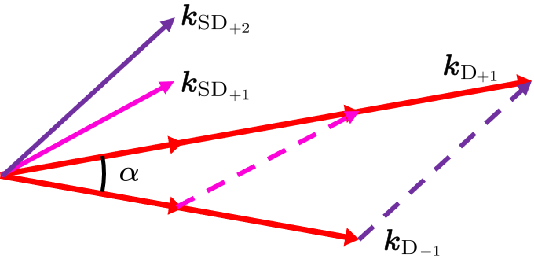
Fig. 1. The phase matching of SD process.
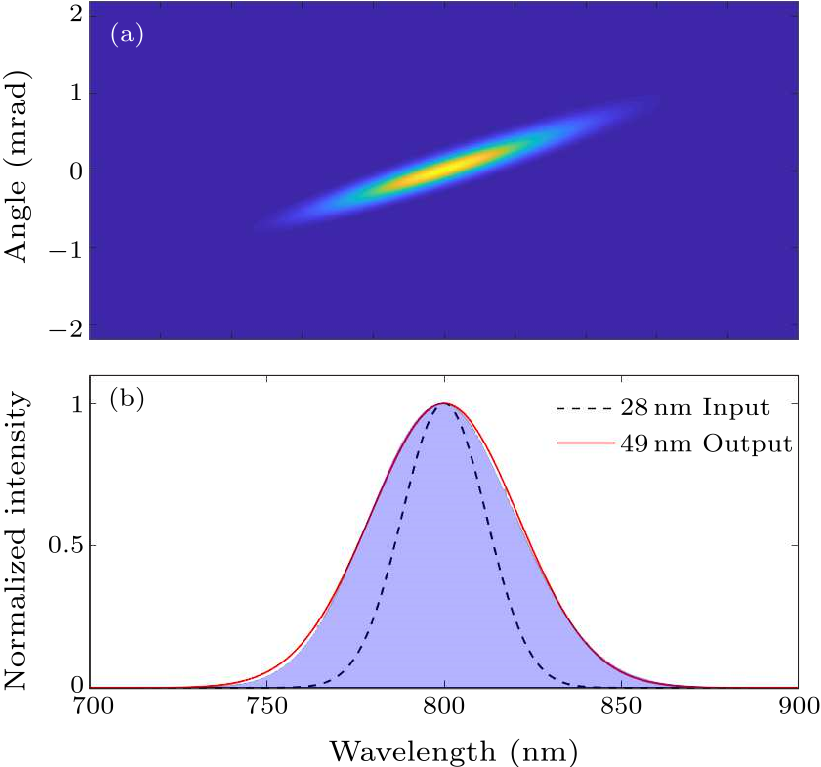
Fig. 2. Spectral properties of SD signal calculated from the phase matching condition. The spectrum width of input pulse is 28 nm and the cross angle of ${\boldsymbol k} _{{\rm D}_{+1}}$ and ${\boldsymbol k} _{{\rm D}_{-1}}$ is 0.5$^{\circ}$. (a) Angular dispersion of the SD$_{+1}$ pulse. (b) Spectrum of the SD$_{+1}$ pules. Blue area: the angle-integrated spectrum from (a). Red solid curve: output spectrum with Gaussian distribution of 49 nm FWHM. Black dashed curve: input spectrum with Gaussian distribution of 28 nm FWHM

Fig. 3. Detailed structure of the SD pulse cleaner. The inset is the photo of generated SD signals and residual incident pulses. BS: beam splitter. A1, A2: attenuator. L1, L2: lens. FS: fused silica.
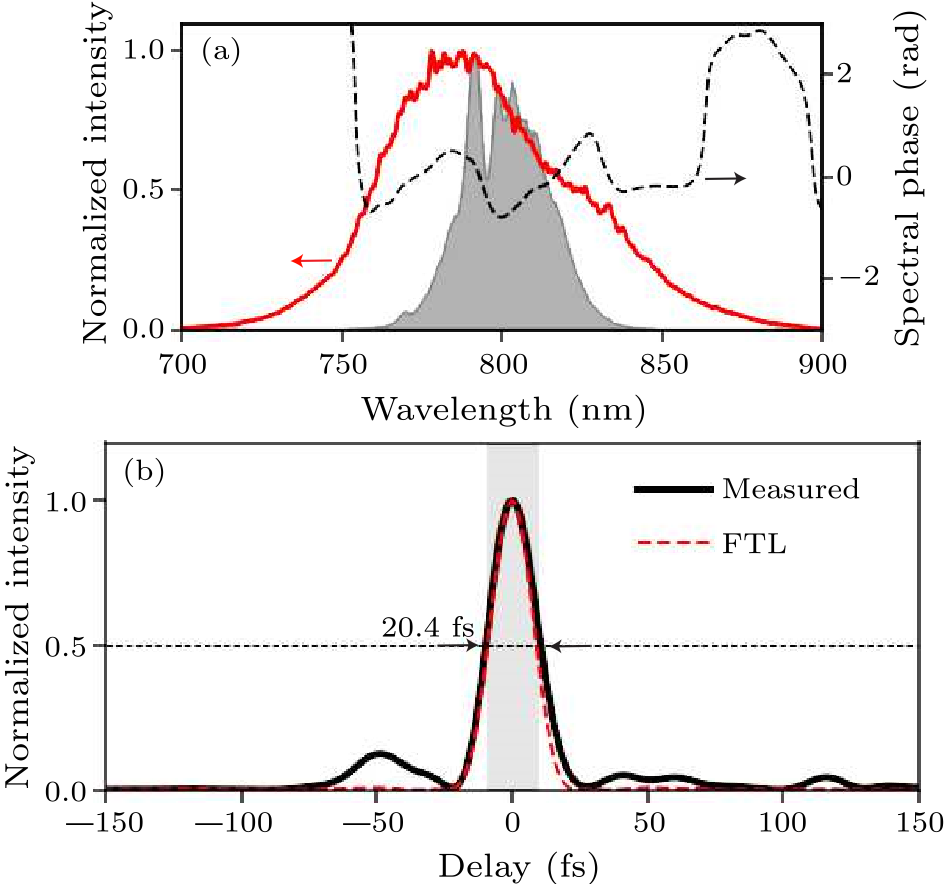
Fig. 4. (a) The spectrum of SD$_{+1}$ signal was smoother and broader than that of incident pulses. Shaded area: the spectrum of incident pulses. Red line: the spectrum of the SD$_{+1}$ signal. Black dashed line: the spectral phase of the SD$_{+1}$ signal after a pair of chirp mirrors which provides $-80$ fs$^{2}$ of GDD. (b) The pulse duration of the SD$_{+1}$ signal after a pair of chirp mirrors which provides $-80$ fs$^{2}$ of GDD.
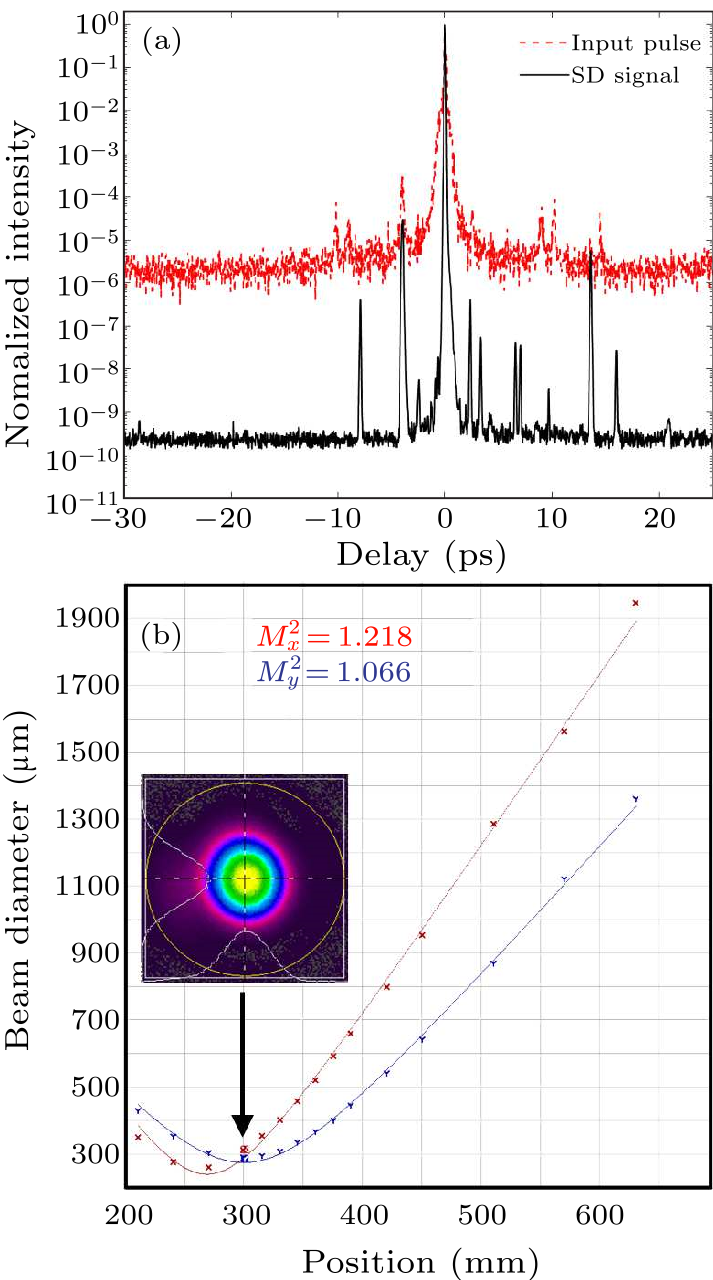
Fig. 5. (a) The temporal contrast of SD$_{+1}$ signal. (b) The spatial quality of SD$_{+1}$ signal.

Fig. 6. Schematic diagram of the whole DCPA system.
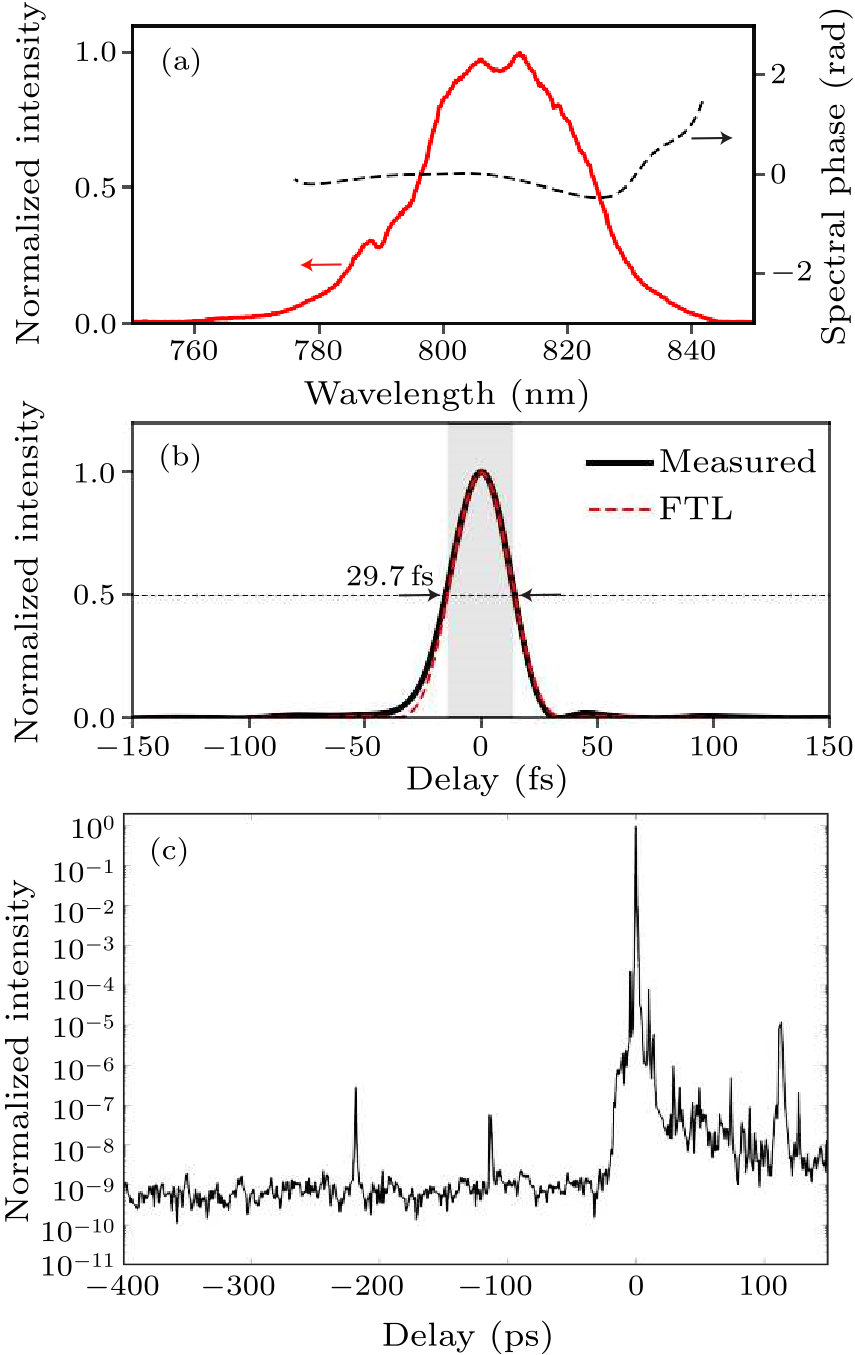
Fig. 7. (a) The spectrum of the compressed pulse. Black dashed line: residual spectral phase of compressed pulse. (b) Pulse duration of the compressed pulse. (c) Temporal contrast of the amplified pulse.
| [1] | Strickland D and Mourou G 1985 Opt. Commun. 55 447 | Compression of amplified chirped optical pulses
| [2] | Wang Z, Liu C, Shen Z, Zhang Q, Teng H, and Wei Z 2011 Opt. Lett. 36 3194 | High-contrast 116 PW Ti:sapphire laser system combined with a doubled chirped-pulse amplification scheme and a femtosecond optical-parametric amplifier
| [3] | Sung J H et al. 2017 Opt. Lett. 42 2058 | 42 PW, 20 fs Ti:sapphire laser at 01 Hz
| [4] | Li W et al. 2018 Opt. Lett. 43 5681 | 339 J high-energy Ti:sapphire chirped-pulse amplifier for 10 PW laser facility
| [5] | Lureau F et al. 2020 High Power Laser Sci. Eng. 8 E43 | High-energy hybrid femtosecond laser system demonstrating 2 × 10 PW capability
| [6] | Guo Z et al. 2018 Opt. Express 26 26776 | Improvement of the focusing ability by double deformable mirrors for 10-PW-level Ti: sapphire chirped pulse amplification laser system
| [7] | Kiriyama H et al. 2018 Opt. Lett. 43 4595 | High-contrast high-intensity repetitive petawatt laser
| [8] | Yoon J W, Jeon C, Shin J, Lee S K, Lee H W, Choi I W, Kim H T, Sung J H, and Nam C H 2019 Opt. Express 27 20412 | Achieving the laser intensity of 55×10 22 W/cm 2 with a wavefront-corrected multi-PW laser
| [9] | Tanaka K A et al. 2020 Matter Radiat. Extremes 5 024402 | Current status and highlights of the ELI-NP research program
| [10] | Kiriyama H, Miyasaka Y, Sagisaka A, Ogura K, Nishiuchi M, Pirozhkov A S, Fukuda Y, Kando M, and Kondo K 2020 Opt. Lett. 45 1100 | Experimental investigation on the temporal contrast of pre-pulses by post-pulses in a petawatt laser facility
| [11] | Ivanov V V, Maksimchuk A, and Mourou G 2003 Appl. Opt. 42 7231 | Amplified spontaneous emission in a Ti:sapphire regenerative amplifier
| [12] | Didenko N V, Konyashchenko A V, Lutsenko A P, and Tenyakov S Y 2008 Opt. Express 16 3178 | Contrast degradation in a chirped-pulse amplifier due to generation of prepulses by postpulses
| [13] | Kalashnikov M P, Risse E, Schönnagel H, and Sandner W 2005 Opt. Lett. 30 923 | Double chirped-pulse-amplification laser: a way to clean pulses temporally
| [14] | Itatani J, Faure J, Nantel M, Mourou G, and Watanabe S 1998 Opt. Commun. 148 70 | Suppression of the amplified spontaneous emission in chirped-pulse-amplification lasers by clean high-energy seed-pulse injection
| [15] | Liu C, Wang Z, Li W, Zhang Q, Han H, Teng H, and Wei Z 2010 Opt. Lett. 35 3096 | Contrast enhancement in a Ti:sapphire chirped-pulse amplification laser system with a noncollinear femtosecond optical-parametric amplifier
| [16] | Jullien A et al. 2005 Opt. Lett. 30 920 | 10^?10 temporal contrast for femtosecond ultraintense lasers by cross-polarized wave generation
| [17] | Liu J, Okamura K, Kida Y, and Kobayashi T 2010 Opt. Express 18 22245 | Temporal contrast enhancement of femtosecond pulses by a self-diffraction process in a bulk Kerr medium
| [18] | Li F, Shen X, Wang P, Li Y, Liu J, Wang Z, and Li R 2016 Laser Phys. Lett. 13 055303 | Temporal contrast improvement based on the self-diffraction process with a cylinder mirror
| [19] | Nighan W L, Gong T, Liou L, and Fauchet P M 1989 Opt. Commun. 69 339 | Self-diffraction: A new method for characterization of ultrashort laser pulses
| [20] | Kane D J and Trebino R 1993 IEEE J. Quantum Electron. 29 571 | Characterization of arbitrary femtosecond pulses using frequency-resolved optical gating
| [21] | Shen X, Wang P, Liu J, and Li R 2018 High Power Laser Sci. Eng. 6 e23 | Linear angular dispersion compensation of cleaned self-diffraction light with a single prism
| [22] | Qin S, Wang Z H, Yang S S, Shen Z W, Dong Q L, and Wei Z Y 2017 Chin. Phys. Lett. 34 024205 | Spectral-Phase-Modulated Cross-Polarized Wave for Chirped Pulse Amplifier with High Contrast Ratio
| [23] | Xie N, Zeng X, Wang X, Zhou K, Sun L, Zuo Y, Huang X, and Su J 2019 Optik 178 279 | Suppression of prepulses by a temporal pulse cleaner based on a self-diffraction process for an ultraintense femtosecond laser
| [24] | Ohmae G, Yagi T, Nanri K, and Fujioka T 2000 Jpn. J. Appl. Phys. 39 5864 | Spatial Spectrum Chirp Characteristic of a Martinez-Type Multipass Pulse Stretcher